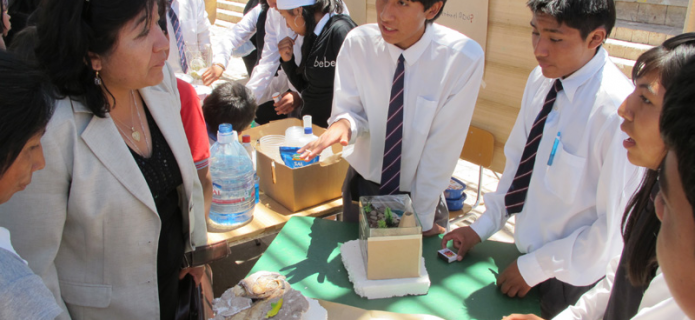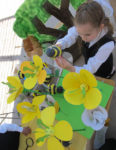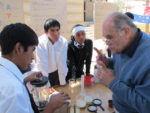ALMA, an astronomical observatory committed to local development
On Tuesday, November 30th, the students of School E-21 in Toconao held a master class as part of the educational improvement plan of this school sponsored by ALMA (Atacama Large Millimeter/submillimeter Array). During the class, the students used exhibits to showcase what they have learned in science and English with parents, teachers, other members of the community and local officials, including the mayoress of San Pedro de Atacama, Sandra Berna; Jorge Allende, Chilean National Science Prize winner; and Thijs de Graauw, the Director of ALMA.
“ALMA has always been committed to developing collaborative, long-term relationships with local communities," says Thijs de Graauw, the Director of ALMA. “Thus, we have worked together with the municipality of San Pedro de Atacama and its respective communities to contribute to the development of education and promote interaction among diverse stakeholders –ALMA, community and authorities– around common goals.”
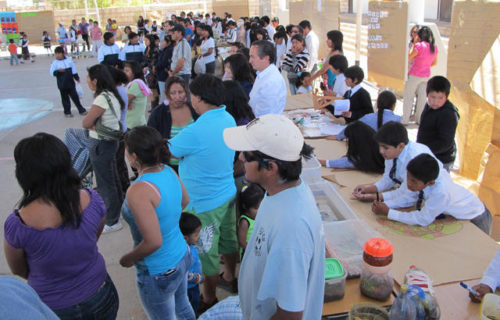 |
| Girls and boys from the preschool transition level to eighth grade participated in the Master Class on November 30th, 2010. They shared their knowledge and skills with the members of the Toconao community, including local authorities. They also displayed their stage talent and communication skills in the English language. Credit: ALMA (ESO/NAOJ/NRAO). |
Guided by the principle of collaboration, ALMA has been supporting an educational improvement plan at School E-21 in Toconao since 2008. This plan, endorsed by the community, is focused on improving learning in science and English.
“ALMA is very committed to local development, including the area of education," explains Sandra Berna, the mayoress of San Pedro de Atacama. “When ALMA presented its improvement plan proposal, I saw the program’s enormous potential to enable the children and youth of Toconao to get access to better learning opportunities. The City Council also backed the plan enthusiastically. The school’s scores on the 2009 SIMCE test (a national standardized test taken at 4th grade level), which significantly improved with respect to the previous year, are evidence that all efforts coalesce to produce positive results. The most important aspect here is that our children's eyes have been opened up to the world of science.”
To improve understanding of the natural environment, the inquiry-based science education program (Programa de Educación en Ciencias Basada en la Indagación, ECBI) has been implemented with the support and supervision of experts from Universidad de Chile. The objective has been to enable the girls and boys of primary school to explain the world that surrounds them by using scientific procedures. To improve English language learning, the school has incorporated the teaching methodology and practices successfully used by Colegio San Luis de Antofagasta, tailoring the program to meet the specific needs of the Toconao school. The methodological basis of this program is to develop communication skills in English at the pre-kinder and kinder and throughout primary school so the students achieve an adequate command in terms of verbal and written understanding and communication.
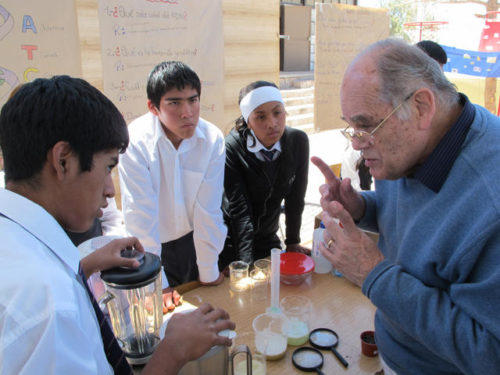 |
| Dr. Jorge Allende, winner of Chile’s National Science Prize, talking with one of the students of the Toconao School E-21 during the Master Class held on November 30th, 2010. Credit: ALMA (ESO/NAOJ/NRAO). |
“Implementing innovative ways of teaching science and English triggered a mini-revolution at the school,” says Eduardo Navarrete, the principal of School E-21 in Toconao. “As teachers, we were all very enthusiastic about the project but also somewhat nervous because we knew it would bring many changes, both in our teaching methods and in the school itself. ALMA has accompanied us throughout the process, organizing training sessions for teachers, taking the whole educational team to Santiago to share experiences with colleagues who are already using the same methodology, bringing English teachers from Colegio San Luis to the school, purchasing teaching materials and audiovisual equipment, equipping the classrooms, hiring two English teachers who work for the program and who also provide evening classes to adults in the community. In two years, it is impressive to see how the students have become more autonomous and more confident in their abilities, and have improved their command of the English language."
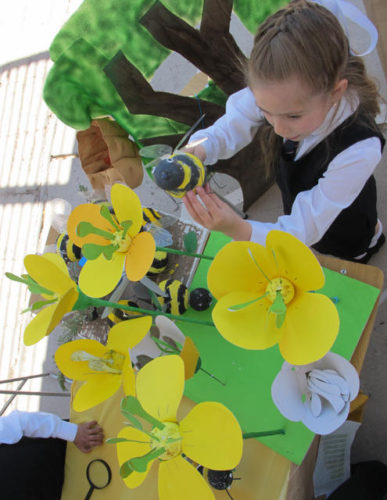 |
| One of the students of the Toconao School E-21 explaining the role of bees in the ecosystem during the Master Class held on November 30th, 2010. Credit: ALMA (ESO/NAOJ/NRAO). |
Girls and boys from the pre-kinder and kinder to eighth grade participated in the master class. They shared their knowledge and skills in physics, chemistry and biology through games, experiments, chemical reactions, observation of animal behavior, and handling of elements, among other activities. They also displayed their stage talent and communication skills in the English language. Students from rural schools in Rio Grande, Solor and San Pedro de Atacama were also invited and interacted with the children from Toconao sharing new experiences.
ALMA, the largest astronomical project in existence, is a revolutionary telescope, comprising an array of 66 giant 12-meter and 7-meter diameter antennas observing at millimeter and submillimeter wavelengths. ALMA will start scientific observations in 2011.
The Atacama Large Millimeter/submillimeter Array (ALMA), an international astronomy facility, is a partnership of the European Organisation for Astronomical Research in the Southern Hemisphere (ESO), the U.S. National Science Foundation (NSF) and the National Institutes of Natural Sciences (NINS) of Japan in cooperation with the Republic of Chile. ALMA is funded by ESO on behalf of its Member States, by NSF in cooperation with the National Research Council of Canada (NRC) and the Ministry of Science and Technology (MOST) in Taiwan and by NINS in cooperation with the Academia Sinica (AS) in Taiwan and the Korea Astronomy and Space Science Institute (KASI).
ALMA construction and operations are led by ESO on behalf of its Member States; by the National Radio Astronomy Observatory (NRAO), managed by Associated Universities, Inc. (AUI), on behalf of North America; and by the National Astronomical Observatory of Japan (NAOJ) on behalf of East Asia. The Joint ALMA Observatory (JAO) provides the unified leadership and management of the construction, commissioning and operation of ALMA.
MORE INFORMATION ABOUT SCHOOL E-21 IN TOCONAO:
School E-21 is a rural public education establishment in Toconao, in the municipality of San Pedro de Atacama. It has students at all levels of primary education and the preschool transition level. Its student body consists largely of girls and boys from the Likan Antai ethnic group. Considered a micro-establishment, it has a boarding school for children from other Atacameño schools in the municipality.
- Director: Mr. Eduardo Navarrete Cruzat,
e-mail: [email protected];
phone: (55) 852022. - Student body: 147 students.
- Management and educational teams and assistants:
1 director; 1 curriculum manager; 11 teachers; 5 teaching assistants (including boarding school supervisors).
